


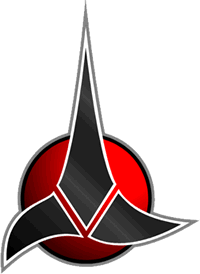 |  | |||||
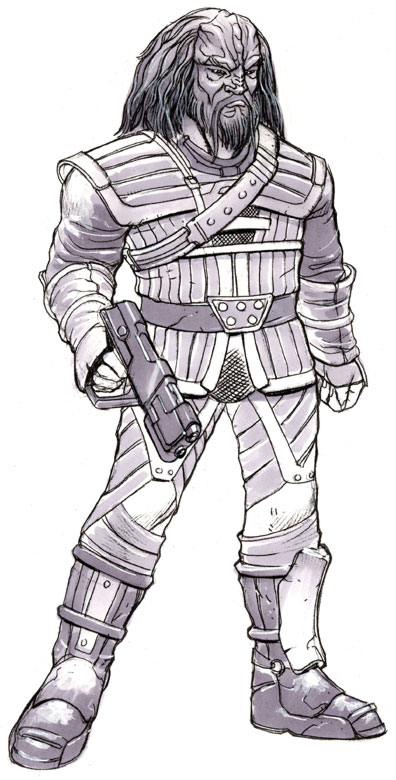 | Society The decline of Clingohn culture is demonstrated in the acts of the Clingohns themselves. They stopped caring about their weapons to the point that they let them rust and even stopped caring for true honor. Sometime after the augment virus took hold of the Clingohn Empire a new regime took control turning the Empire into a fascist state that kept tabs on all who served. The old ways returned in the latter 23rd and early 24th centuries respectively. Males traditionally dominated public life in the Empire, assuming the leading roles in politics and the military with only rare exceptions. A notable exception to the prohibition of women serving on the High Council came when Azetbur became Chancellor of the High Council after her father, Gorkon, was assassinated in 2293. Women, in turn, traditionally dominated the household and the management of the family's affairs. Clingohn women were treated as equals except in politics and matters of inheritance. They were prohibited by law from serving in the High Council and could not take control of their Houses unless they have the money and no male successors of the lineage. Otherwise, Clingohn women were expected to exhibit the same physical prowess and lust for blood and honor as the men. Clingohn society functioned through a system of family reputation and honor. Tradition was an integral part of their lives and breaking from observances was considered a grievous insult to society, an insult that is not forgotten easily. An offense usually brought shame to the offender's name for several generations. The highest shame was Discommendation, an action by the High Council to officially strip a Clingohn of his personal or family honor. Bloodlines and relations were also taken very seriously by any "true" Clingohn. Lines comprise more than mere family members. An integral part of tradition was the various rituals that mark milestones in a Clingohn's life or the history of the Empire. Most notable of the rites was the Rite of Succession, which a future leader of the Empire must complete with a valid Arbiter of Succession overseeing the proceedings. Before the Rite can begin, there was another elaborate ceremony needed to confirm the death of the previous leader. This was known as the Sonchi ceremony. Individual Clingohn warriors were expected to go through the Rite Of Ascension to be recognized as a full adult. If the house that an individual Clingohn belongs to is dissolved or falls into dishonor, he can be adopted into another house through the R'uustai or alternative ceremonies that symbolically mark the joining of kinship and allegiance. Clingohns were extremely territorial. According to the first known Clingohn linguist, there was no such thing as an "insignificant corner of Clingohn space." Physiology The most distinctive feature of Clingohn anatomy (except in those individuals afflicted with the Augment Virus) was a sagittal crest, beginning on the forehead and often continuing over the skull. The cranium was encased in an exoskeleton, which possesses a feature known as the tricipital lobe. On average, Clingohns were larger and physically stronger than most other species, though they possessed a much lower tolerance for cold weather. They also lack tear ducts. Internally, Clingohn anatomy was markedly different from that of that of other species; There is a great deal more multiple redundancy in their organs, a principle they call Brak'lul. This allowed Clingohns to survive severe injuries in battle. They had twenty-three ribs, two livers, an eight chambered heart, three lungs, and even redundant neural function and multiple stomachs. Some geneticists believed that the extra organs, notably the third lung, evolved to give Clingohns greater stamina on the battlefield. Surprisingly, Clingohns had relatively little knowledge of their own biology and their medicine was very poorly developed. This was largely due to their warrior traditions- A Clingohn who is wounded was expected to be left to survive through his own strength, die, or to undergo the hegh'bat, a form of ritual suicide. It is interesting to note that, despite the anatomical and physiological differences between Clingohns and other species, they have very similar nutritional requirements: As one doctor noted, "What kills us, kills them." Clingohn pregnancies normally ran thirty weeks, but with mixed species, gestation times were shorter. The odds against Clingohn Newblood conceptions were rather high; However, when successful, Clingohn and Human metabolisms sometimes clashed, causing biochemical fluctuations in the mother, which may lead to fainting. Clingohn traits remained dominant for several generations, even with a single ancestor; Therefore, a child even 25% Clingohn still possessed forehead ridges if he or she carried the gene. Clingohns had ridged spines, chests and feet. After birth some Clingohn infants experienced a pronounced curvature to the spine, which was correctable by surgery. This "defect" tended to run in Clingohn families, especially among females. After the Federate was defeated by the Remulous Hemogeny, doctors who managed to escape brought with them the knowledge of how to correct this quickly and easily, and as such the defect is relatively uncommon in adults. Clingohn children matured far more quickly than other speices. At the age of only one Earth year, a Clingohn child had the appearance a Human child had at about four. By the age of eight Earth years, a Clingohn attained the maturity a Human did not reach until about age sixteen. When Clingohn children began growing into adults, they went through jak'tahla, a Clingohn form of puberty. Like other mammalian species, Clingohn females were capable of lactating to breast-feed infants. Clingohns tended to live for over 150 years, but even into advanced old age, they tended to still be strong enough for combat. Doctor BASHIR Julian once sarcastically noted that the natural odor produced by Clingohns was comparable to an "earthy, peaty aroma with a hint of lilac." Clingohns had the instinctive ability to sense the decision to kill by looking into the eyes of their opponents. While this is not true, they do seem to sense who around them would most likely mean them harm. | |||||
| 3D6 | ||||||
| 2D6+3 | ||||||
| 3D6 | ||||||
| 4D6 | ||||||
| 3D6 | ||||||
| 4D6 | ||||||
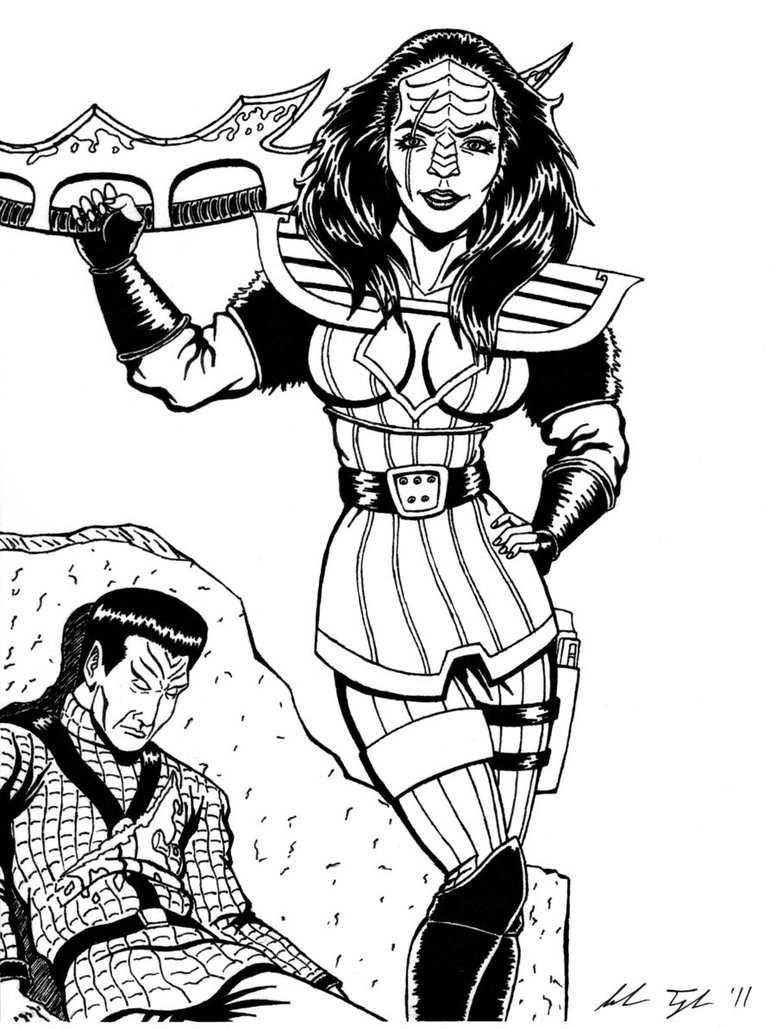 | 3D6 | |||||
| 3D6 | ||||||
| 2D6+PE+2D4 per level of experience. | ||||||
| 1D6 times 10 plus physical skills. | ||||||
| 2D6 | ||||||
| 3D6 | ||||||
| Not applicable. | ||||||
| Any. | ||||||
| Per OCC. | ||||||
| None. | ||||||
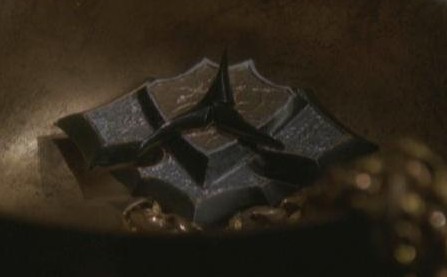 Redundancy: Redundant organs and internal systems give the Clingohns a +4 to save vs non toxic poisons and +2 to save vs toxic poisons. Also they gain a +15% to save vs coma/death. | | |||||
| Speak Clingohn 98%. | ||||||
| 5 ft 8 inches to 7 ft. | | |||||
| 165 to 300 lbs. | ||||||
| Qo'noS (pronounced Kronos). | ||||||
| Any men at arms. Rarely is there a Clingohn Scholar or Adventurer type but they are possible. | ||||||
| Yes. | | |||||
| Religion And Tradition Ritual was a very important element in Clingohn society. While the Clingohns were not a religious people as such, they did believe that deities existed at one time. However, Clingohn warriors supposedly slew their gods as they were considered to be more trouble than they were worth. Clingohns did not believe in fate; However, they did appear to believe in some form of luck. Once a Clingohn died, the spirit was considered to have exited the body, leaving behind a worthless shell to be disposed of. In the Clingohn death ritual, it was traditional for those on hand to howl into the sky as a warning to the afterlife that a Clingohn warrior was about to arrive. In some cases a funeral dirge was sung in memory of the deceased, or friends sat with the body to protect it from predators, a practice known as ak'voh. Furthermore, a Clingohn who was unable to fight, and hence is unable to live as a warrior anymore, had the traditional obligation of committing the hegh'bat, which was the Clingohn ritual suicide. Tradition dictated that the eldest son or a close personal friend must assist. That person's role was to hand the dying Clingohn a knife so that he can plunge it into his heart, remove it, and then wipe the blood on his own sleeve. The Clingohn afterlife was supposedly divided into two branches. The dishonored were taken to Gre'thor aboard the Barge of the Dead, a vessel captained by Kortar, the first Clingohn. Kortar was supposedly the one who had originally killed the gods who created him and was condemned to ferry the dishonored to Gre'thor as a punishment. Once in Gre'thor, the dishonored were watched over by Fek'lhr, a vaguely Clingohn-esque figure. While it may be tempting to view Fek'lhr as the Clingohn equivalent of the Human devil, the Clingohns do not believe in a "devil" any more than they now believe in the gods. Those who die honorably supposedly went to Sto-vo-kor, where Kahless was said to await them. However, should a noble warrior die in a manner that might not merit a place in Sto-vo-kor, such as being assassinated in a surprise attack, he may still earn a place if others dedicate a great battle to his name, thus showing that he has earned respect among the living. Clingohn rituals included the R'uustai, a bonding ceremony which joined two people together in a relationship similar to brotherhood. Clingohn tradition holds that "the son of a Clingohn is a man the day he can first hold a blade." If a Clingohn warrior strikes another Clingohn with the back of his hand, it was interpreted as a challenge to the death. Clingohn warriors speak proudly to each other; They did not whisper or keep their distance. Standing far away or whispering were considered insults in Clingohn society. When going into battle, Clingohn warriors often sing the traditional warriors' anthem, which is essentially an invocation to Kahless and a pledge to win a good death in battle. When choosing a mate, it is traditional for a female Clingohn to bite the male's face, allowing her to taste his blood and get his scent. Clingohn daughters traditionally are given a piece of jewelry called a jinaq when they become old enough to select a mate. Groups The Order of Kahless, named for Kahless the Unforgettable, was one of the most prestigious groups in the Clingohn Empire. The recipient was awarded the Star of Kahless from the Clingohn Chancellor. The award itself is still given, but not as an official UGC award; It is, however, recognized outside the Clingohn Alliance, on par with the Legion Of Merit with Cluster. In 2375, Martok was inducted into the Order of Kahless for his actions in the Dominion War in a ceremony aboard Deep Space 9. Chancellor Gowron presided over the ceremony. After the Battle of Chamra Vortex, 217TH Fleet Commander Jesancia HORV'TH was similarly honored, one of relatively few non-Clingohn Empire members to be so honored. (Admiral HORV'TH would later represent the UGC when the Clingohns sued to enter the UGC; Her reputation with the Clingohns was bolstered by the fact that she had a wickedly ugly scar from this very battle.) The Great Houses The Tuqmey Dun (Great Houses) were a Clingohn feudalistic social organization that dominated the Clingohn Empire. Each House was usually led by the eldest male of the ruling family for whom the House was named. His wife was the Mistress of the Great House. The Houses are political entities, and lesser famial units may or may not intrinsically be part of a given house, unless they are common descendants to a House; Many "house less" families exist, mostly of commoners. Habitat: Clint prefer an urban environment typically. Farming is something for toy'wI''a', not warriors. Alliances and Allies: Their primary ally currently is the United Galaxies Council, which is a firm alliance but can at times be cool as well. The UGC isn't as concerned about their treatment of slavery, they are more concerned about the Rite Of Succession, and moreso who wins this contest and how; Civil war was often used in the past to choose the new Emperor, and this is NOT in the Council's interest. A truly democratic process is incomprehensible to the Clints, a kind of rough and ready democracy has evolved as contenders to the throne view their oppositions potential power and choose to press their claim or not accordingly. 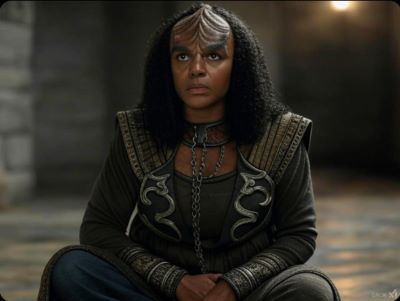 Slavery Clingohns have a very mixed view on slavery; It is rarely practiced amongst Clingohn, though in exceptionally dishonorable cases it has happened that leaders may be placed in prison camps and carry the word toy'wI''a' (slave) even though they really are technically just criminals serving a sentence. Clingohns who serve on the loosing side of an internal war were not typically enslaved at the close of the conflict if they'd served their leaders honorably; Indeed, the loosing side's leaders were rarely imprisoned if they'd fought honorably. Assuming they had, they might even be ignored, and their forces would be returned to their previous duties. Leaders who had acted dishonorably were typically just executed and done with. Non-Clingohn species that the empire conquered on the other hand were routinely enslaved to the last survivor. The rare major exception to this rule was voluntary enslavement; This is typically seen only in houseless Clingohns, who make a choice to accept dishonor and often discommendation in exchange for their lives and house and food- And rarely anything more. Few escape their state, but they often take relief in the fact that they are no longer in poverty and homeless. Voluntary Slavery Homeless and houseless Clingohn will sometime offer themselves to one or another House as toy'wI''a' in exchange for a home, usually under terrible conditions even by Clingohn standards. The typical term of service is life, though exceptions have been seen. Involuntary Slavery The Clingohn routinely enslaved non-Clingohn peoples they'd conquered over the centuries. Well before the founding of the Tiresian Republic they'd begun loosening their control over their subject populations, and most are toy'wI''a' in name only. Most are more like serfs, with some degree of rights. The major exceptions are the Xepolites, who staged a reasonably successful uprising and brokered this into limited freedom, and the Federate worlds during the empire's occupation of those worlds after the fall of the Federate due to the desire to deny these worlds to the Remulous and to the "dishonorable" way that victory had been achieved. After the annexation of the Atran Galaxy, the former Federate worlds were returned to the new Federate March. The diffrence n treatment between Clingohn and non-Clingohn slaves is striking; A non-Clingohn slave is rarely mistreated, and is more likely to be ignored provided they do not give the march cause to notice them, whereas a Clingohn slave can look forward to a lifetime of abuse and neglect. This is primarily due to a diffrence in perception between the two; A Clingohn is expected to be a warrior no matter what, whereas other species are not, and that some can be is an interesting surprise. | ||||||


